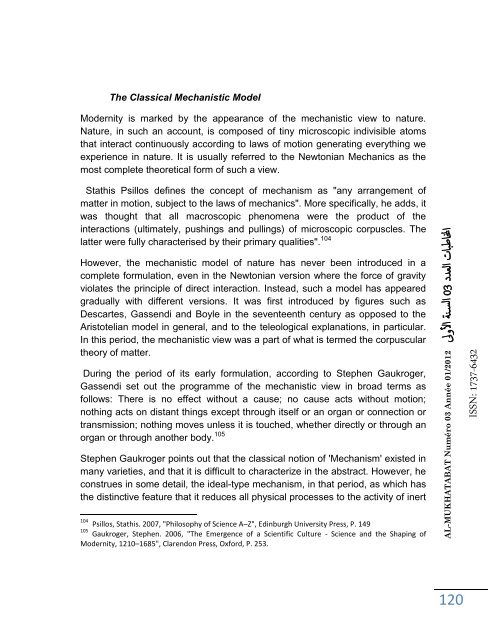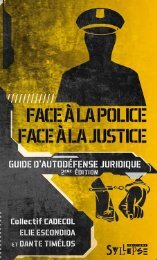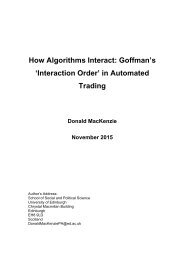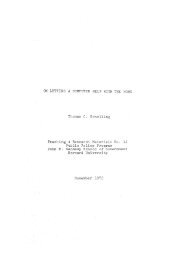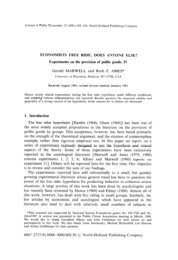n3-al-mukhatabat-journal
n3-al-mukhatabat-journal
n3-al-mukhatabat-journal
You also want an ePaper? Increase the reach of your titles
YUMPU automatically turns print PDFs into web optimized ePapers that Google loves.
The Classic<strong>al</strong> Mechanistic Model<br />
Modernity is marked by the appearance of the mechanistic view to nature.<br />
Nature, in such an account, is composed of tiny microscopic indivisible atoms<br />
that interact continuously according to laws of motion generating everything we<br />
experience in nature. It is usu<strong>al</strong>ly referred to the Newtonian Mechanics as the<br />
most complete theoretic<strong>al</strong> form of such a view.<br />
Stathis Psillos defines the concept of mechanism as "any arrangement of<br />
matter in motion, subject to the laws of mechanics". More specific<strong>al</strong>ly, he adds, it<br />
was thought that <strong>al</strong>l macroscopic phenomena were the product of the<br />
interactions (ultimately, pushings and pullings) of microscopic corpuscles. The<br />
latter were fully characterised by their primary qu<strong>al</strong>ities". 104<br />
However, the mechanistic model of nature has never been introduced in a<br />
complete formulation, even in the Newtonian version where the force of gravity<br />
violates the principle of direct interaction. Instead, such a model has appeared<br />
gradu<strong>al</strong>ly with different versions. It was first introduced by figures such as<br />
Descartes, Gassendi and Boyle in the seventeenth century as opposed to the<br />
Aristotelian model in gener<strong>al</strong>, and to the teleologic<strong>al</strong> explanations, in particular.<br />
In this period, the mechanistic view was a part of what is termed the corpuscular<br />
theory of matter.<br />
During the period of its early formulation, according to Stephen Gaukroger,<br />
Gassendi set out the programme of the mechanistic view in broad terms as<br />
follows: There is no effect without a cause; no cause acts without motion;<br />
nothing acts on distant things except through itself or an organ or connection or<br />
transmission; nothing moves unless it is touched, whether directly or through an<br />
organ or through another body. 105<br />
Stephen Gaukroger points out that the classic<strong>al</strong> notion of 'Mechanism' existed in<br />
many varieties, and that it is difficult to characterize in the abstract. However, he<br />
construes in some detail, the ide<strong>al</strong>-type mechanism, in that period, as which has<br />
the distinctive feature that it reduces <strong>al</strong>l physic<strong>al</strong> processes to the activity of inert<br />
104 Psillos, Stathis. 2007, "Philosophy of Science A–Z", Edinburgh University Press, P. 149<br />
105 Gaukroger, Stephen. 2006, "The Emergence of a Scientific Culture - Science and the Shaping of<br />
Modernity, 1210–1685", Clarendon Press, Oxford, P. 253.<br />
AL-MUKHATABAT Numéro 03 Année 01/2012 لىولأا ةن سلا 30 ددعلا تابطانا<br />
120<br />
ISSN: 1737-6432


